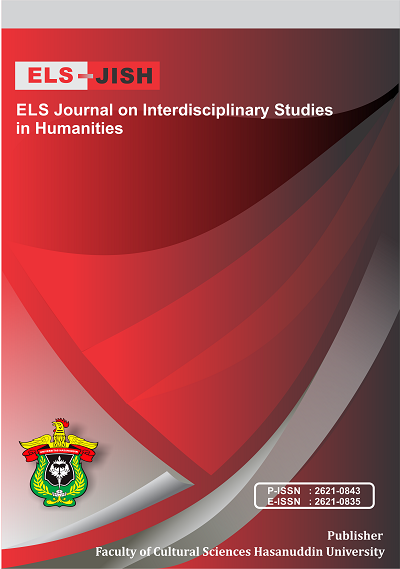Parents’ and Teachers’ Views on Academic Performance among Multilingual Young Learners
DOI:
https://doi.org/10.34050/elsjish.v7i1.31487Keywords:
Academic Performance, Multilingualism, Young LearnersAbstract
This research focuses on young learners with multi-language ability, Indonesian & English, in its implementation at both school and home. This study examined how young students can speak Indonesian and English fluently as well as how it affects their academic performance at school. The main sources of information in this study were parents and teachers. Data were collected from 1 tuition center and 1 elementary school in Manado. The data included questionnaire, interview notes from both parents and teachers, along with researcher’s observation notes. Academic performance of students is measured based on semester report from schools and quarterly report from tutoring consisting of 3 subjects, English, Science, and math. Those subjects selected are considered as preeminent subject by teachers and parents. The research results factors supporting young learners be able to speak more than one language and how multilingualism affects the academic performance of young learners at school on those 3 selected subjects.
References
Andini, C. (2017). Children Emotion in The Movie" Big Hero 6 (Doctoral dissertation, Doctoral dissertation, Universitas Islam Negeri Alauddin Makassar).
Armstrong, P. W. and Rogers, J. D., "Basic Skills Revisited: The Effects of Foreign Language Instruction on Reading Math and Language Arts". Learning Languages, 2(3), 1997, 20-31.
Aswad, M., Rahman, F., Said, I. M., Hamuddin, B., & Nurchalis, N. F. (2019). A software to increase English learning outcomes: An acceleration model of English as the second language. The Asian EFL Journal, 26(6.2), 157.
Baum, D. R., Hernandez, J. E., & Orchard, A. (2019). Early childhood education for all: A mixed-methods study of the global policy agenda in Tanzania. Early Years, 39(3), 260-275.
Berk, L. E. (2022). Infants and children: Prenatal through middle childhood. SAGE Publications, New York: Pearson.
Chakravarthi, B. R., Priyadharshini, R., Ponnusamy, R., Kumaresan, P. K., Sampath, K., Thenmozhi, D., ... & McCrae, J. P. (2021). Dataset for identification of homophobia and transophobia in multilingual YouTube comments. arXiv preprint arXiv:2109.00227.
Eliot, L. & Syc, S. (2008). "Language and the Brain". In Linda, Gilkerson and Rebecca Klein, (eds.). Early Development and the Brain: Teaching Resources for Educators. Erikson faculty Development Project on the Brain, Washington D.C. Zero-to-Three.
Hasnia, H., Andini, C., Tahir, M. D., Hunaeni, H., Zulfikariandi, Z., & Muslimin, M. T. (2022). The Ability of 1st Class Students of SMAN 11 Enrekang to Arrange Verbal and Nominal Sentences. ELS Journal on Interdisciplinary Studies in Humanities, 5(3), 539-550.
Hernandez, A. E., Bates, E. A., & Avila, L. X. (1994). On-line sentence interpretation in Spanish–English bilinguals: What does it mean to be “in between”?. Applied Psycholinguistics, 15(4), 417-446.
Huang, T., Loerts, H., & Steinkrauss, R. (2022). The impact of second-and third-language learning on language aptitude and working memory. International Journal of Bilingual Education and Bilingualism, 25(2), 522-538.
Jordens, K., Van den Branden, K., & Van Gorp, K. (2018). Multilingual islands in a monolingual sea: Language choice patterns during group work. International Journal of Bilingual Education and Bilingualism, 21(8), 943-955.
Karlsson, L. C., Soveri, A., Räsänen, P., Kärnä, A., Delatte, S., Lagerström, E., ... & Laine, M. (2015). Bilingualism and performance on two widely used developmental neuropsychological test batteries. PLoS One, 10(4), e0125867./journal.pone.01258567.
McLean, J. E., & Snyder-McLean, L. K. (1978). A Transactional Approach to Early Language Training. Columbus, Ohio: Merrill.
Petitto, L. A., Katerelos, M., Levy, B. G., Gauna, K., Tétreault, K., & Ferraro, V. (2001). Bilingual signed and spoken language acquisition from birth: Implications for the mechanisms underlying early bilingual language acquisition. Journal of child language, 28(2), 453-496.
Piper, T. (1998). Language and learning: The home and school years. Merrill Prentice-Hall, Inc., Order Processing, PO Box 11071, Des Moines, IA 50336-1071.
Pupynina, M., & Aralova, N. (2021). Lower Kolyma multilingualism: Historical setting and sociolinguistic trends. International Journal of Bilingualism, 25(4), 1081-1101.
Rahman, F. (2016). The Strategy of Teaching Literature through Language-based Methods: A Communicative Approach. In Annual Seminar on English Language Studies (Vol. 1, pp. 156-170).
Rahman, F., & Weda, S. (2018). Students’ perceptions in appreciating English literary works through critical comment: A case study at Hasanuddin University and Universitas Negeri Makassar. Asian EFL Journal, 20(3), 149-172.
Ray, R. (2021). Impact Of Multilingual Approach to Education on Young Learners in India. Journal of Scientific Research, 65(09), 58-62.
Downloads
Published
Issue
Section
License
Copyright (c) 2024 Muh. Hasan Basri

This work is licensed under a Creative Commons Attribution-ShareAlike 4.0 International License.






